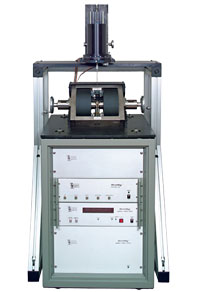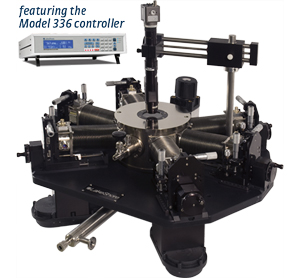Brad C. Dodrill, Lake Shore Cryotronics, Inc.
Magnetometers are used to characterize magnetic material properties. Magnetometry techniques can be broadly classified into two categories: inductive and force-based. Common inductive methods include vibrating sample magnetometry (VSM), extraction magnetometry, AC susceptometry and superconducting quantum interference device (SQUID) magnetometry. The two most commonly used inductive techniques are VSM and SQUID magnetometry. Alternating gradient magnetometry (AGM) is the most often used force-based technique. The measurement most commonly performed to characterize a material’s magnetic properties is that of a major hysteresis loop. The hysteresis or M(H) loop is typically used to determine a material’s saturation magnetization Ms (the magnetization at maximum applied field), remanence Mr (the magnetization at zero applied field after applying a saturating field) and coercivity Hc (the field required to demagnetize the material). More complex magnetization curves covering states with field and magnetization values located inside the major hysteresis loop, such as first-order-reversal-curves (FORCs), can provide additional information that can be used to characterize magnetic interactions and coercivity distributions in magnetic materials[1].
Three important considerations in determining which type of magnetometer is best suited to specific magnetic materials are; a) sensitivity as this determines the smallest magnetic moment that may be measured with acceptable signal-to-noise, b) measurement speed, e.g., the time required to measure a hysteresis loop, as this determines sample throughput, c) temperature and field range over which measurements are to be performed. Measurement speed is particularly important for FORC measurements because a typical series of FORCs can contain thousands to tens of thousands of data points. This article discusses some of the techniques currently used in the characterization of magnetic materials, and presents typical measurement results that demonstrate the sensitivity and measurement speed of an electromagnet-based VSM.
First-Order-Reversal-Curve
A FORC is measured by saturating a sample in a field Hsat, decreasing the field to a reversal field Ha, then sweeping the field back to Hsat in a series of regular field steps Hb. This process is repeated for many values of Ha yielding a series of FORCs. The measured magnetization at each step as a function of Ha and Hb gives M(Ha,Hb). The FORC distribution ρ(Ha,Hb) is the mixed second derivative, that is, ρ(Ha,Hb) = –(1/2)∂2 M(Ha,Hb)/∂Ha∂Hb. A FORC diagram is a 2D or 3D contour plot of ρ(Ha,Hb) with the axis rotated by changing coordinates from (Ha,Hb) to Hc=(Hb–Ha)/2 and Hu=(Hb+Ha)/2 where Hu corresponds to the distribution of interaction or reversal fields and Hc the distribution of switching or coercive fields.
FORC has been extensively used by earth and planetary scientists studying the magnetic properties of natural samples because FORC can distinguish between single-domain (SD), multi-domain (MD), and pseudo single-domain (PSD) behavior, and because it can distinguish between different magnetic mineral species[2]. It has also been used to characterize interactions and coercivity distributions in magnetic recording media[3,4], nanowire arrays[5], exchange coupled permanent magnets[6] and exchanged biased magnetic multilayers[7]. Finally, while it is very difficult to unravel the complex magnetic signatures of multiphase magnetic materials from a hysteresis loop measurement alone, FORC can differentiate between phases in such materials[8, 9, 10].
Magnetic Measurement Techniques
Vibrating Sample Magnetometry
In vibrating sample magnetometry, originally developed by Simon Foner[11] of MIT’s Lincoln Laboratory, a magnetic material is vibrated within a uniform magnetic field H, inducing an electric current in suitably placed sensing coils. The resulting voltage induced in the sensing coils is proportional to the magnetic moment of the sample. The magnetic field may be generated by an electromagnet or a superconducting magnet. VSM measurements can be performed from <2 K to 1,273 K using integrated cryostats or furnaces.
Commercial VSM systems provide measurements to field strengths of ~3.4 T (34,000 Oe) using conventional electromagnets [12,13], as well as systems employing superconducting magnets to produce fields to 16 T [14,15]. When used with electromagnets, very small step changes in field can be made (i.e., ~1 mOe) and the measurement is very fast. A typical hysteresis loop measurement can take as little as a few seconds to a few minutes.
When used with superconducting magnets, higher field strengths are possible; however, this limits the field setting resolution, and the measurement speed is inherently slower due to the speed at which the magnetic field can be varied using superconducting magnets. A typical hysteresis M(H) loop measurement can take one hour or more. Additionally, magnetometers employing superconducting magnets are more costly to operate since they require liquid helium. Cryogen-free systems employing closed cycle refrigerators, and also liquefiers that recover helium in liquid helium based systems are available, but these represent an expensive capital equipment investment. An advantage of superconducting magnet systems is that they reach higher magnetic fields than air- or water-cooled electromagnets, which is necessary to saturate some magnetic materials, such as rare earth permanent magnet materials. The noise floor of commercially available VSMs is 10–7 to 10-8 emu.
Superconducting Quantum Interference Device Magnetometry
Quantum mechanical effects in conjunction with superconducting detection coil circuitry are used in superconducting quantum interference device (SQUID) based magnetometers to measure the magnetic properties of materials. Theoretically, SQUIDs are capable of achieving sensitivities of 10–12 emu, but practically, they are limited to sensitivities of 10–8 emu because the SQUID also picks up environmental noise. As in a VSM, SQUIDs may be used to perform measurements from low to high temperatures (from <2 K to 1,000 K). Superconducting magnets with field strengths up to 7 T are employed in SQUIDs[14,15]; therefore, the measurement is inherently slow due to the speed at which the magnetic field can be varied, as is the case for superconducting magnet-based VSM systems. A typical hysteresis M(H) loop measurement can take one hour or more.
Alternating Gradient Magnetometry (AGM)
Force methods involve determination of the apparent change in weight for a material when placed in an inhomogeneous magnetic field. The sample experiences a force f along the axis of the field gradient (dH/dz), which is given by f = m(dH/dz) where m is the magnetic moment. The equipment required for such force methods are either an electro- or superconducting magnet, and a balance for force measurements. A commercial variant of these methods is the alternating gradient magnetometer[12]. AGMs are capable of achieving sensitivities in the 10–8 to 10–9 emu range, and like the VSM, the AGM is a very fast measurement; a typical hysteresis loop takes seconds to minutes. Commercial AGM systems can be used for ambient temperature measurements to the moderate 2 to 3 T fields achievable with electromagnets.
Since a series of FORCs contain many data points the measurement can be very time consuming when using superconducting magnet based systems (days to weeks), whereas electromagnet based systems can acquire the data much more quickly (minutes to hours). In the FORC measurement it is necessary to fully saturate a material after each reversal field excursion, thus superconducting magnet systems must be used for some materials.
Electromagnet Based VSM: Sensitivity and Speed
Sensitivity
A VSM’s sensitivity depends on a number of factors:
• Electronic sensitivity.
• Noise rejection through signal conditioning.
• Amplitude and frequency of mechanical drive.
• Thermal noise of sensing coils.
• Optimized design and coupling (proximity) of sensing coils to the sample under test.
• Vibration isolation of the mechanical head assembly from the electromagnet and
VSM sensing coils.
• Minimization of environmental mechanical and electrical noise sources which can
deleteriously effect VSM sensitivity.
The voltage induced in the VSM sensing coils is given by:
Vemf = mAfS
Where:
m = magnetic moment
A = amplitude of vibration
f = frequency of vibration
S = sensitivity function of VSM sense coils.
It’s clear from this equation that increasing A, f or S, will improve moment sensitivity. S may be increased by either increasing the coupling between the sense coils and the sample under test (i.e., minimize gap spacing), or by optimizing the design of the sense coils (i.e., number of windings, coil geometry, etc.) And, of course, signal averaging also improves sensitivity. The data shown in this article were recorded using a Lake Shore Model 8600 VSM.
Figure 1 shows typical noise measurement results at 100 ms/point (left) and 10 s/point (right) averaging. Note that the vertical axis is expressed in nemu (10–9 emu). The RMS noise values are noted in the figure caption.

As an illustration of the sensitivity of the VSM, typical low moment measurement results are presented for a CoPt thin film with saturation moment msat = 20 µemu.
Figure 2 shows hysteresis loops as a function of signal averaging. Note that the vertical axis is expressed in μemu (10-6 emu). These loops were recorded for ±5 kOe in 25 Oe steps at signal averages of 100 ms/point (left) and 1 s/point (right), which equates to total loop measurement times of 1 minute 25 seconds and 13 minutes 30 seconds, respectively. The peak-to-peak noise in the saturated region of the hysteresis loops are completely consistent with the measured RMS noise values at the same signal averages.

Speed
The VSM has been designed for fast measurements, providing field ramp rates to 10 kOe/s, and data acquisition as fast as 10 ms/point. Figure 3 shows typical hysteresis loop measurement results for a magnetic stripe (left) with saturation moment of 14 memu (10–3 emu), and CoPt thin film (right) with saturation moment of 80 µemu. The magnetic stripe loop was recorded for ±10 kOe in 50 Oe steps at 10 ms/point in 13 seconds, and the loop for the CoPt thin film was recorded for ±4 kOe in 25 Oe steps at 100 ms/point in only 69 seconds.

As noted previously, the first-order-reversal-curve (FORC) technique is becoming increasingly important in characterizing magnetic material properties because it provides information regarding magnetic interactions and coercivity distributions, information that cannot be obtained from a hysteresis loop measurement alone. A typical series of FORCs can contain thousands of data points and thus the measurement can be very time consuming if the measurement speed of the magnetometer is slow. Figure 4 shows 46 FORCs (2,012 data points) recorded at 30 ms/point in 4 minutes 32 seconds for the same magnetic stripe sample shown in figure 3 (left), and 100 FORCs (8,818 data points) recorded at 500 ms/point in 1 hour and 20 minutes for the same CoPt thin film shown in Figure 3 (right).

Summary
In this article we have discussed the advantages and disadvantages of the most commonly used inductive and force based magnetometry methods. We’ve presented measured RMS noise data for an electromagnet based VSM[12] as function of signal averaging, and also typical results for a CoPt thin film with saturation moment of only 20 µemu. Results of fast hysteresis loop and FORC measurements have been presented as well demonstrating the measurement speed of the VSM, which is particularly important in acquiring FORC data.
Brad C. Dodrill graduated from The Ohio State University in 1982 with a BSc degree in Physics and a minor in Mathematics. He completed 2 years of graduate studies in Physics and Electrical Engineering and took a position with Lake Shore Cryotronics in 1984 as a Research Scientist. He is currently the Vice President of Sales and a Senior Scientist at Lake Shore. In his technical capacity, he is active in applications and product development initiatives in the areas of magnetic and electronic measurements and materials. He has 40 paper publications to his credit, holds three US patents, and has lectured at numerous universities and technical conferences in the US, Europe and Asia.
For more information, visit lakeshore.com.
References
[1] C. R. Pike, A. P. Roberts, K. L. Verosub, “Characterizing Interactions in Fine Particle Systems Using First-Order-Reversal-Curves”, J. Appl. Phys., 85, 6660, 1999.
[2] A. P. Roberts, C. R. Pike, K. L. Verosub, “First-Order Reversal-Curve Diagrams: A New Tool for Characterizing the Magnetic Properties of Natural Samples”, J. Geophys. Res., 105, 461, 2000.
[3] B. F. Valcu, D. A. Gilbert, K. Liu, “Fingerprinting Inhomogeneities in Recording Media Using the First Order Reversal Curve Method”, IEEE Trans. Mag., 47, 2988, 2011.
[4] M. Winklhofer, R. K. Dumas, K. Liu, “Identifying Reversible and Irreversible Magnetization Changes in Prototype Patterned Media Using First- and Second-Order Reversal Curves”, J. Appl. Phys, 103, 07C518, 2008.
[5] B. C. Dodrill, L. Spinu, “First Order Reversal Curve Analysis of Nanoscale Magnetic Materials”, Technical Proceedings of the 2014 NSTI Nanotechnology Conference and Expo, CRC Press, 2014.
[6] Y. Cao, M. Ahmadzadeh, K. Xe, B. Dodrill, J. McCloy, “Simulation and Quantitative Analysis of FORC Diagrams for Single Phase and Multiphase System Using Preisach Hysteron Distribution Pattern”, submitted to J. Mag. Mag. Mat., 2017.
[7] B. C. Dodrill, “First Order Reversal Curve (FORC) Studies of Nanoscale Magnetic Materials”, Technical Proceedings of the 2017 TechConnect World Innovation Conference and Expo, CRC Press, 2017
[8] B. C. Dodrill, “First-Order-Reversal-Curve Analysis of Nanocomposite Permanent Magnets”, Technical Proceedings of the 2015 TechConnect World Innovation Conference and Expo, CRC Press, 2015.
[9] B. C. Dodrill, “First-Order-Reversal-Curve Analysis of Multi-phase Ferrite Magnets”, Magnetics Business and Technology, Spring 2015.
[10] C. Carvallo, A. R. Muxworthy, D. J. Dunlop, “First-Order-Reversal-Curve (FORC) Diagrams of Magnetic Mixtures: Micromagnetic Models and Measurements”, Physics of the Earth and Planetary Interiors, 154, 308, 2006.
[11] S. Foner, “Versatile and Sensitive Vibrating Sample Magnetometer”, Rev. Sci. Inst., 30, 548, 1959.
[12] Lake Shore Cryotronics, USA; www.lakeshore.com
[13] Microsense, USA; www.microsense.net
[14] Quantum Design, USA; www.qdusa.com
[15] Cryogenic Limited, UK; www.cryogenic.co.uk



